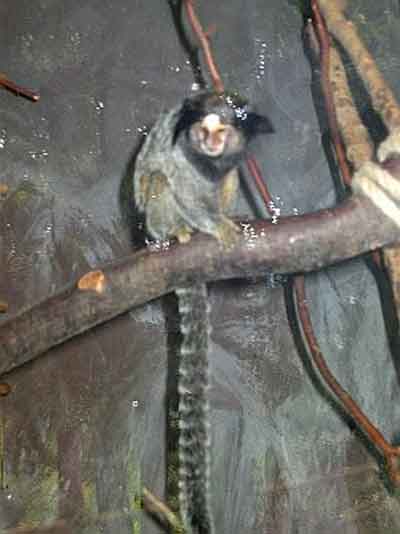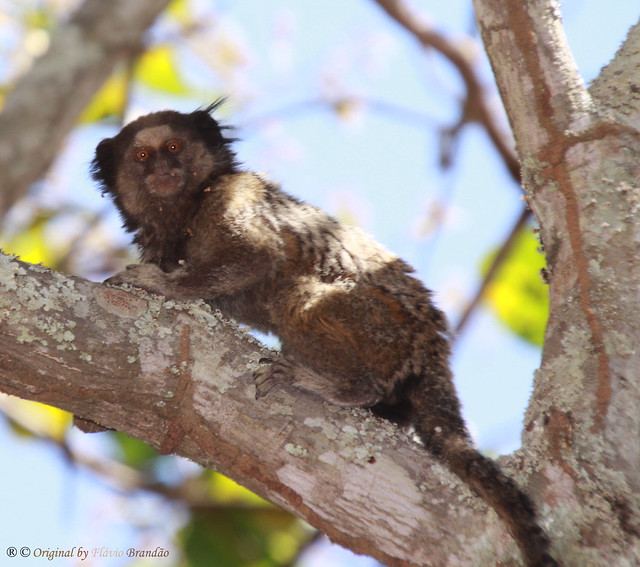Callithrix penicillata (*) Cladus: Eukaryota Name Callithrix penicillata (É. Geoffroy, 1812) Vernacular names Callithrix penicillata ------- The Black-tufted Marmoset (Callithrix penicillata), also known as Mico-estrela in Portuguese, is a species of New World monkey that lives primarily in the Neo-tropical gallery forests of the Brazilian Central Plateau. It ranges from Bahia to Paraná,[3] and as far inland as Goiás, between 14 and 25 degrees south of the equator. This marmoset typically resides in rainforests, living an arboreal life high in the trees, but below the canopy. They are only rarely spotted near the ground.
The Black-tufted Marmoset is characterized by black tufts of hair around their ears. It typically has some sparse white hairs on its face. It usually has a brown or black head and its limbs and upper body are gray, as well as its abdomen, while its rump and underside are usually black. Its tail is ringed with black and white and is not prehensile, but is used for balance. It does not have an opposable thumb and its nails tend to have a claw-like appearance. The Black-tufted Marmoset reaches a size of 19 to 22 cm and weighs up to 350 g. Behavior Diurnal and arboreal, the Black-tufted Marmoset has a lifestyle very similar to other marmosets. It typically lives in family groups of 2 to 14. The groups usually consist of a reproductive couple and their offspring. Twins are very common among this species and the males, as well as juvenile offspring, often assist the female in the raising of the young. Though the Black-tufted Marmoset lives in small family groups, it is believed that they share their food source, sap trees, with other marmoset groups. Scent marking does occur within these groups, but it is believed that the marking is to deter other species rather than other Black-tufted Marmoset groups, because other groups typically ignore these markings. They also appear to be migratory, often moving in relation to the wet or dry seasons, however, the extent of their migration is unknown. Though communication between Black-tufted Marmosets has not been studied thoroughly, it is believed that it communicates through vocalizations. It has known predator-specific cries and appears to vocalize frequently outside of predator cries. Food and predation The Black-tufted Marmoset diet consists primarily of tree sap which it gets by nibbling the bark with its long lower incisors. In periods of drought, it will also include fruit and insects in its diet. In periods of serious drought it has also been known to eat small arthropods, molluscs, bird eggs, baby birds and small vertebrates. Large birds of prey are the greatest threat to the Black-tufted Marmoset, however, snakes and wild cats also pose a danger to them. Predator-specific vocalizations and visual scanning are its only anti-predation techniques. Reproduction The Black-tufted Marmoset is monogamous and lives in family groups. It reproduces twice a year, producing 1 to 4 offspring, though most often just twins. Its gestation period is 150 days and offspring are weaned after 8 weeks. There is considerable parental investment by this species, with both parents, as well as older juveniles, helping to raise the young. The offspring are extremely dependent on their parents and though they are sexually mature at 18 months, they typically do not mate until much later, staying with their family group until they do. Ecosystem roles and conservation status The Black-pencilled Marmoset is a mutualist with many species of fruit trees because it distributes the seeds from the fruit it consumes throughout the forests. However, it is a parasite on other species of trees because it creates sores in trees in order to extract sap, while offering no apparent benefit to the trees. Though this marmoset is not a main food source to any specific species, it is a food source to a number of different species, specifically large birds of prey, wild cats, and snakes. While there are no known negative effects of marmosets towards humans, it carries specific positive effects by being a highly valuable exotic pet. It is also used in zoo exhibits and scientific research. The Black-tufted Marmoset is listed as having no special status on the IUCN Red List or the United States Endangered Species Act List. It is listed in Appendix II of CITES and is not currently considered an endangered or threatened species. References and notes Footnotes 1. ^ Groves, C. (2005). Wilson, D. E., & Reeder, D. M, eds. ed. Mammal Species of the World (3rd ed.). Baltimore: Johns Hopkins University Press. pp. 132. ISBN 0-801-88221-4. OCLC 62265494. http://www.bucknell.edu/msw3/browse.asp?id=12100205.
* Barros, M., C. Alencar, C. Tomaz. 2004. Differences in Aerial and Terrestrial Visual Scanning in Captive Black Tufted-ear Marmosets (Callithrix penicillata) Exposed to a Novel Environment. Folia Primatologica, 75/2: 85-91. Source: Wikipedia, Wikispecies: All text is available under the terms of the GNU Free Documentation License |
|



